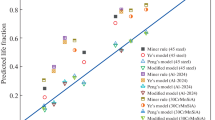Abstract
A new continuum damage mechanics model for fretting fatigue life prediction is established. In this model, the damage evolution rate is described by two kinds of quantities. One is associated with the cyclic stress characteristics obtained by the finite element (FE) analysis, and the other is associated with the material fatigue property identified from the fatigue test data of standard specimens. The wear is modeled by the energy wear law to simulate the contact geometry evolution. A two-dimensional (2D) plane strain FE implementation of the damage mechanics model and the energy wear model is presented in the platform of ABAQUS to simulate the evolutions of the fatigue damage and the wear scar. The effect of the specimen thickness is also investigated. The predicted results of the crack initiation site and the fretting fatigue life agree well with available experimental data. Comparisons are made with the critical plane Smith-Watson-Topper (SWT) method.
Similar content being viewed by others
References
Hills, D. A. and Nowell, D. Mechanics of Fretting Fatigue, Kluwer Academic Publishers, Dordrecht, 1–14 (1994)
Nowell, D., Dini, D., and Hills, D. A. Recent developments in the understanding of fretting fatigue. Engineering Fracture Mechanics, 73, 207–222 (2006)
Nishioka, K. and Hirakawa, K. Fundamental investigations of fretting fatigue: part 6, effects of contact pressure and hardness of materials. Bulletin of the JSME, 15, 135–144 (1972)
Szolwinski, M. P. and Farris, T. N. Mechanics of fretting crack formation. Wear, 198, 93–107 (1996)
Lykins, C. D., Mall, S., and Jain, V. An evaluation of parameters for predicting fretting fatigue crack initiation. International Journal of Fatigue, 22, 703–716 (2000)
Araujo, J. A. and Nowell, D. The effect of rapidly varying contact stress fields on fretting fatigue. International Journal of Fatigue, 24, 763–775 (2002)
Naboulsi, S. and Mall, S. Fretting fatigue crack initiation behavior using process approach and finite element analysis. Tribology International, 36, 121–131 (2003)
Zhang, T., McHugh, P. E., and Leen, S. B. Finite element implementation of multiaxial continuum damage mechanics for plain and fretting fatigue. International Journal of Fatigue, 44, 260–272 (2012)
Hojjati-Talemi, R. and Abdel-Wahab, M. Fretting fatigue crack initiation lifetime predictor: using damage mechanics approach. Tribology International, 60, 176–186 (2013)
McColl, I. R., Ding, J., and Leen, S. B. Finite element simulation and experimental validation of fretting wear. Wear, 256, 1114–1127 (2004)
Madge, J. J., Leen, S. B., and Shipway, P. H. The critical role of fretting wear in the analysis of fretting fatigue. Wear, 263, 542–551 (2007)
Madge, J. J., Leen, S. B., McColl, I. R., and Shipway, P. H. Contact-evolution based prediction of fretting fatigue life: effect of slip amplitude. Wear, 262, 1159–1170 (2007)
Zhang, T., McHugh, P. E., and Leen, S. B. Computational study on the effect of contact geometry on fretting behavior. Wear, 271, 1462–1480 (2011)
Fouvry, S., Liskiewicz, T., Kapsa, P. H., Hannel, S., and Sauger, E. An energy description of wear mechanisms and its applications to oscillating sliding contacts. Wear, 255, 287–298 (2003)
Lemaitre, J. and Chaboche, J. L. Mechanics of Solid Materials, Cambridge University Press, Cambridge (1990)
Lemaitre, J. and Rodrigue D. Engineering Damage Mechanics, Springer, New York (2005)
Xiao, Y. C., Li, S., and Gao, Z. T. A continuum damage mechanics model for high cycle fatigue. International Journal of Fatigue, 20, 503–508 (1998)
Fridrici, V., Fouvry, S., and Kapsa, P. H. Effect of shot peening on the fretting wear of Ti-6Al-4V. Wear, 250, 642–649 (2001)
Jin, O. and Mall, S. Effects of slip on fretting behavior: experiments and analysis. Wear, 256, 671–684 (2004)
Jin, O. and Mall, S. Effects of independent pad displacement on fretting fatigue behavior of Ti-6Al-4V. Wear, 253, 585–596 (2002)
Jin, O. and Mall, S. Influence of contact configuration on fretting fatigue behavior of Ti-6Al-4V under independent pad displacement condition. International Journal of Fatigue, 24, 1243–1253 (2002)
United States Department of Defense. Metallic Materials and Elements for Aerospace Vehicle Structures, United States Department of Defense, New York (1998)
Johnson, K. L. Contact Mechanics, Cambridge University Press, Cambridge (1987)
Hibbit, Karlsson and Sorensen Inc. ABAQUS/Standard Version 6.10, User Manual, Hibbit, Karlsson and Sorensen Inc., Rhode Island (2010)
Ding, J., Bandak, G., Leen, S. B., Williams, E. J., and Shipway, P. H. Experimental characterization and numerical simulation of contact evolution effect on fretting crack nucleation for Ti-6Al-4V. Tribology International, 42, 1651–1662 (2009)
Mohd-Tobi, A. L., Ding, J., Bandak, G., Leen, S. B., and Shipway, P. H. A study on the interaction between fretting wear and cyclic plasticity for Ti-6Al-4V. Wear, 267, 270–282 (2009)
Madge, J. J., Leen, S. B., and Shipway, P. H. The critical role of fretting wear in the analysis of fretting fatigue. Wear, 263, 542–551 (2007)
Madge, J. J., Leen, S. B., McColl, I. R., and Shipway, P. H. Contact-evolution based prediction of fretting fatigue life: effect of slip amplitude. Wear, 262, 1159–1170 (2007)
Author information
Authors and Affiliations
Corresponding author
Additional information
Project supported by the National Natural Science Foundation of China (No. 11002010)
Rights and permissions
About this article
Cite this article
Shen, F., Hu, W. & Meng, Q. New approach based on continuum damage mechanics with simple parameter identification to fretting fatigue life prediction. Appl. Math. Mech.-Engl. Ed. 36, 1539–1554 (2015). https://doi.org/10.1007/s10483-015-2002-6
Received:
Revised:
Published:
Issue Date:
DOI: https://doi.org/10.1007/s10483-015-2002-6




